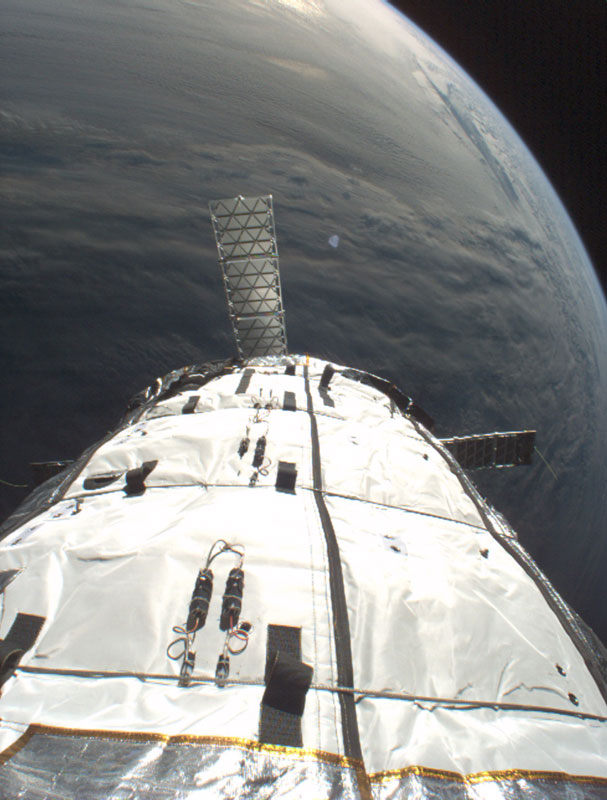- Genesis I
Infobox Space station
station = "Genesis I"
station_
station_image_size =
station_image_caption = Image from one of the seven exterior cameras on "Genesis I".
NSSDC_ID = 2006-029A
sign = NORAD #29252 (1)
crew = Unmanned
launch =July 12 ,2006
14:53:30 UTC (3)
launch_pad =Dombarovskiy base,
Russia (3)
reentry = 2013–2019 (4)
status = On orbit
mass = 1,360 kg
(3,000 lb) (5)
length = 4.4 m (14.4 ft) (2)
diameter = 2.54 m (8.3 ft) (2)
volume = 11.5 m³ (406.1 ft³) (2)
pressure = 51.7 kPa (7.5 psi) (6)
perigee = 521.0 km
(323.7 mi) (1)
apogee = 594.0 km
(369.1 mi) (1)
inclination = 64.51 degrees (1)
speed = 27,243.0 km/h
16,928.0 (mi/h) (2)
period = 95.8 minutes (1)
orbits_day = 15.03 (1)
in_orbit = >500 days (1)
orbits = >7,500 (1)
distance = >324,000,000 km
(200,000,000 mi) (1)
stats_ref = 1cite web |url=http://www.n2yo.com/satellite.php?s=29252 |title=Genesis I satellite details |work=N2YO.com |accessdate=2007-11-30] , 2cite web |url=http://www.bigelowaerospace.com/genesis_I/?Genesis_I_General_Specs |title=Genesis I General Specs |work=BigelowAerospace.com |accessdate=2007-12-20] , 3cite web |url=http://www.russianspaceweb.com/dnepr.html |title=Russia inaugurates new space launch site |work=RussianSpaceWeb.com |date=2006-07-17 |accessdate=2007-06-30] , 4cite news |url=http://www.space.com/missionlaunches/060721_bigelow_genesis-1.html |title=Bigelow Aerospace's Genesis-1 Performing Well |work=Space.com |first=Leonard |last=David |date=2006-07-21 |accessdate=2007-06-30] , 5cite news |url=http://www.msnbc.msn.com/id/18142397/ |title=Private space station test delayed till May |work=MSNBC.com |first=Alan |last=Boyle |date=2007-04-17 |accessdate=2007-06-30] , 6cite news |url=http://www.livescience.com/blogs/2006/07/13/bigelows-genesis-1-performing-well/ |title=Bigelow's Genesis-1 Performing Well |work=LiveScience.com |first=Leonard |last=David |date=2006-07-13 |accessdate=2007-06-30]"Genesis I" is an experimental space habitat designed and built by the private American firm
Bigelow Aerospace and launched in 2006. It was the first module to be sent into orbit by the company, and is testing various systems, materials and techniques related to determining the viability of long-term inflatable space structures. Such structures, including this module and others built by Bigelow Aerospace, are based on theNASA Transhab design, which provides increased interior volume at a reduced launch diameter and potentially reduced mass compared to traditional rigid structures.Spacecraft history
"Genesis I" was launched on
July 12 ,2006 at 14:53:30 UTC aboard anISC Kosmotras Dnepr rocket , launched from Dombarovskiy missile base near Yasniy,Russia . Spacecraft control was transferred to Bigelow Aerospace at 15:08 UTC after a successful orbital insertion. Designed as a one-third scale model of the full size "BA 330 ", when in orbit the main body of the craft measures 4.4 m (14.4 ft) long and 2.54 m (8.3 ft) in diameter, with an interior habitable volume of 11.5 cubic meters (406.1 cubic feet). As part of the expandable design, however, the module launched with a diameter of only 1.6 m (5.25 ft), inflating to its full size after entering orbit.cite news |url=http://www.bigelowaerospace.com/news/?Genesis_II_Calls_Home |title=Genesis II Calls Home, Says It's Doing Fine |work=BigelowAerospace.com |date=2007-06-28 |accessdate=2007-12-20] The expansion process took approximately ten minutes."Genesis I" suffered a major radiation event in December 2006 as a result of a
solar storm . Mission controllers were able to restart the system in time, though the situation was described as being "one fault away from the spacecraft being dead." Despite this, no lasting damage appears to have occurred and the spacecraft was operating in "excellent shape"as of March 2007 .cite news |url=http://www.space.com/spacenews/070326_bigelow_businessmonday.html |title=Bigelow Aerospace Sets a Business Trajectory |work=Space.com |first=Leonard |last=David |date=2007-03-26 |accessdate=2007-08-06]The spacecraft completed its 10,000th orbit on
May 8 ,2008 , some 660 days after launch. Since that launch, "Genesis 1" has traveled the equivalent of more than 270 million miles, which would take it to the Moon and back 1,154 times," and has taken more than 14,000 images, including images of all seven continents. Its electrical equipment has been continuously powered since it first became operational.cite news |url=http://www.space.com/missionlaunches/080509-bigelow-genesis1-milestone.html |title=Private Space Station Prototype Hits Orbital Milestone |work=Space.com |first=Tariq |last=Malik |date=2008-05-09 |accessdate=2008-05-09]Systems
"Genesis I" is outfitted with eight GaAs solar panel arrays, four on each end, which produce one kilowatt total powercite web |url=http://www.spacequest.com/success/bagenesis.php |title=Genesis-I & II |work=SpaceQuest.com |accessdate=2007-06-30] and maintain a 26
volt battery charge.cite news |url=http://www.livescience.com/blogs/2006/07/12/bigelow-module-orbital-updates/ |title=Bigelow Module: Orbital Updates |work=LiveScience.com |first=Leonard |last=David |date=2006-07-12 |accessdate=2007-06-30] The craft carries thirteen cameras, seven external to monitor the physical condition of the spacecraft, such as the outer shell and solar arrays, and six internal to photograph the various objects and experiments. Internal systems established an atmospheric pressure of 7.5 psi (51.7 kPa) and use passive thermal control to keep temperatures at an average of 26 degreesCelsius (79 degreesFahrenheit ), with observed limits of approximately 4.5 °C (40 °F) and 32 °C (90 °F).cite news |url=http://www.bigelowaerospace.com/genesis_I/?Performance |title=Genesis I: Performance |work=BigelowAerospace.com |first=Jay |last=Ingham |date=2007-02-13 |accessdate=2007-12-20] "Genesis I" uses a single gas tank for its inflation system, and guidance/stabilization control is performed using a network of torque rods, sun sensors, GPS and amagnetometer .cite web |url=http://www.bigelowaerospace.com/out_there/genesis_II_difference.php |title="Genesis II" Different From "Genesis I" |work=BigelowAerospace.com |first=Eric |last=Haakonstad |date=2007-03-05 |accessdate=2007-08-04 |archiveurl=http://web.archive.org/web/20070528014400/http://www.bigelowaerospace.com/out_there/genesis_II_difference.php |archivedate=2007-05-28]Payload
Aside from the various systems and monitoring equipment, "Genesis I" is orbiting with a wide variety of cargo. Bigelow employees contributed numerous photographs, toys, cards and other items, which can be seen in still images floating around the cabin. Bigelow also placed a life-sciences experiment on board, which contains
Madagascar hissing cockroach es ("Gromphadorhina portentosa") and so-calledMexican jumping bean s, which are seeds containing the live larva of the moth "Cydia deshaisiana ".cite news |url=http://www.lvrj.com/news/8246747.html |title=NLV firm launches Genesis II |work=Las Vegas Review-Journal |first=John |last=Antczak |date=2007-06-27 |accessdate=2007-06-30] cite news |url=http://www.space.com/missionlaunches/070628_genesis2_update.html |title=Bigelow's Second Orbital Module Launches Into Space |work=Space.com |first=Tariq |last=Malik |coauthors=and Leonard David |date=2007-06-28 |accessdate=2007-06-30] In addition, the company allowed NASA to include a prototype for the GeneSat series of nanosatellites. This device, called GeneBox, tested the systems and procedures that will be used on future GeneSat missions. While GeneBox carries no living organisms, future flights will use sensors and optics to measure how weightlessness affectsgene s and the genetic activity of cells and microscopic life.cite press release |url=http://www.nasa.gov/centers/ames/news/releases/2006/06_52AR.html |title=Bigelow Spacecraft Carries NASA 'Genebox' For Tests In Orbit |publisher=NASA Ames Research Center |date=2006-07-17 |accessdate=2007-06-30] cite news |url=http://www.spaceref.com/news/viewnews.html?id=1147 |title=A Closer Look at NASA's GeneBox Payload |work=SpaceRef.com |first=Keith |last=Cowing |date=2006-07-30 |accessdate=2007-06-30]References
See also
*
Genesis II
*Galaxy (module)
*Sundancer
Wikimedia Foundation. 2010.
